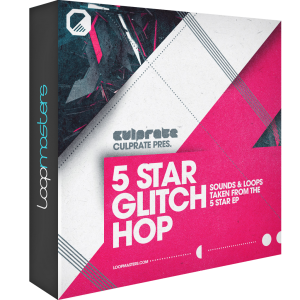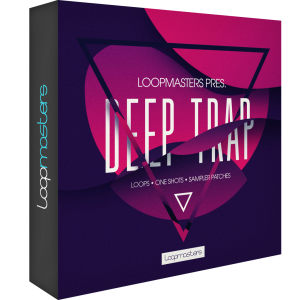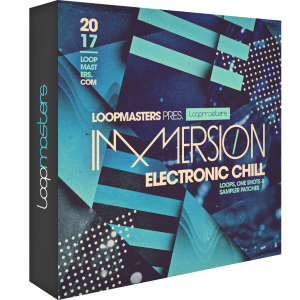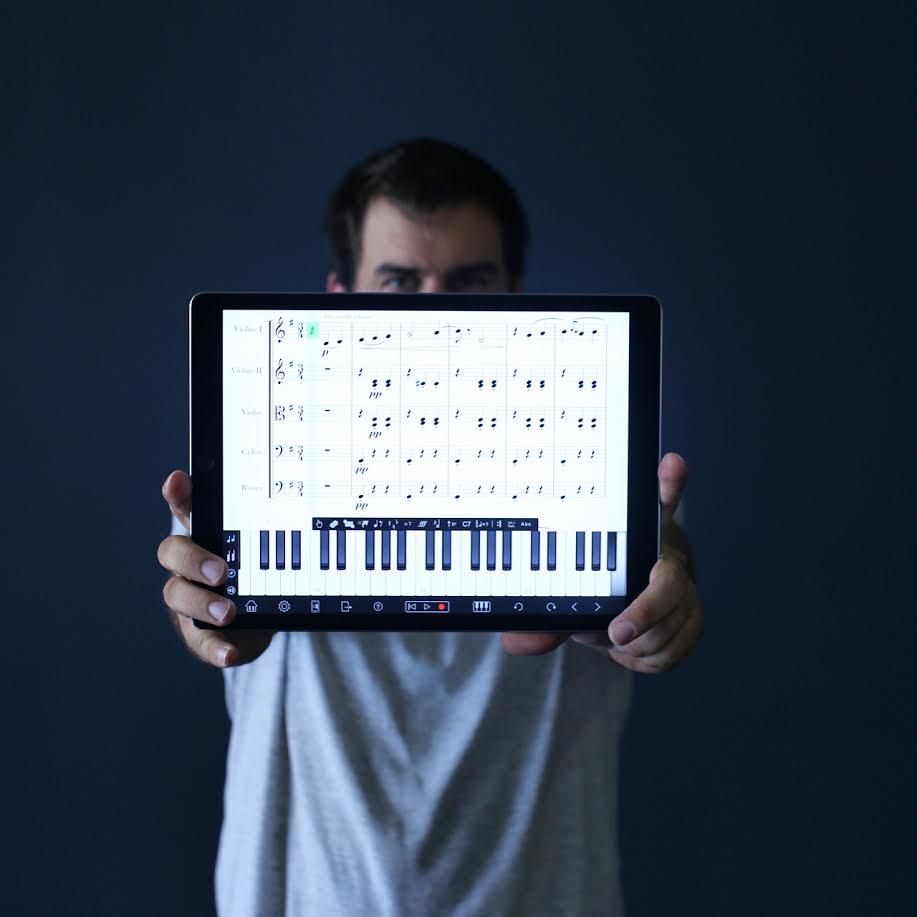Tag Archives: Studio One
Friday Tip of the Week: A Sweeter, Beefier Ampire
A Sweeter, Beefier Ampire
Let’s transform Ampire’s Crunch American from a motor scooter into a Harley. Here’s our point of departure:
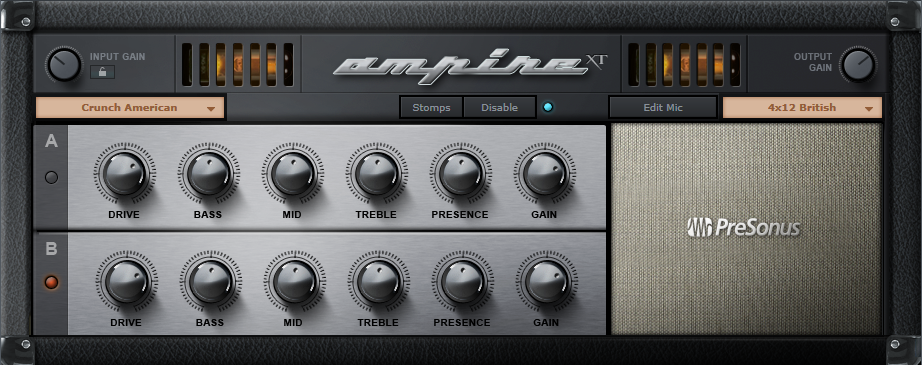
Insert the Multiband Dynamics before Ampire. The default patch is fine, but drag the High Mid and High gain and ratio settings down all the way. The goal here is to add a bit of compression to give more even distortion in the mids and lower mids but also, to get rid of high frequencies that, when distorted, create harsh harmonics.

After Ampire, insert the Pro EQ. The steep notch around 8 kHz gets rid of the whistling sound you’ll really notice in the before-and-after audio example, while the high-frequency shelf adds brightness to offset the reduced high frequencies going into Ampire. But this time, we’re increasing the “good,” post-distortion high frequencies instead of the nasty pre-distortion ones.
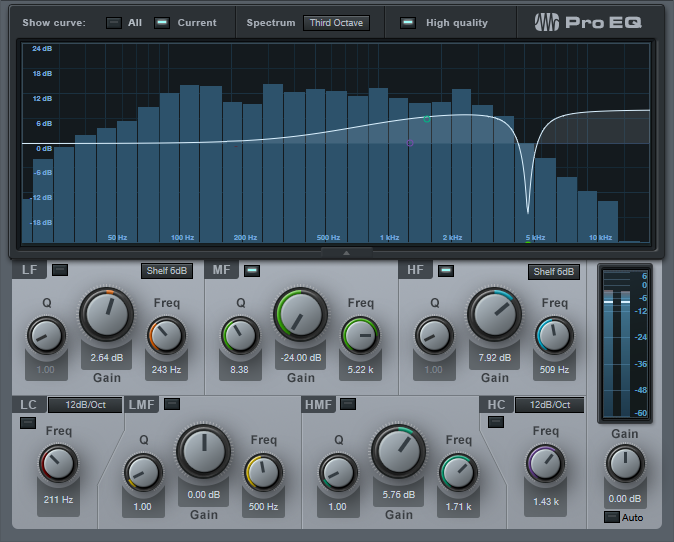
Those two processors alone make a big difference, but let’s face it—people don’t listen to an amp with their ear a couple inches from the speaker, but in a room. So, let’s create a room and give the sound a stereo image with the Open Air convolution reverb. I’ve loaded one of my custom, synthetic IR responses; these are my go-to impulses for pretty much everything I do involving convolution reverb, and may be available in the PreSonus shop someday. Meanwhile, feel free to use your own favorite impulses.
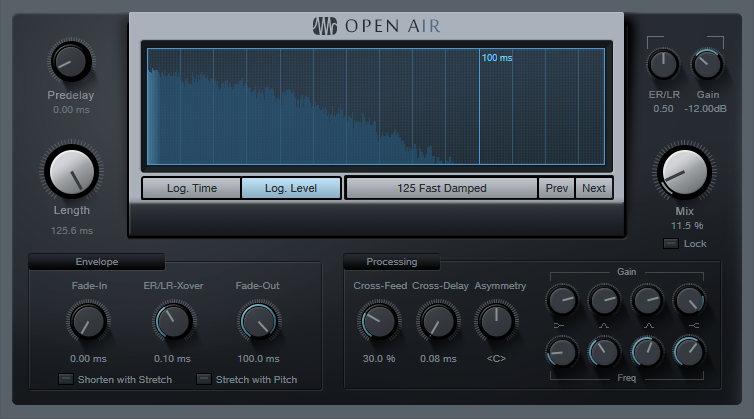
Of course, you can take this concept a lot further with the Channel Editor if you want to tweak specific parameters to optimize the sound for your particular playing style, choice of pickups, pickup type, and the like…hmmm, seems like that might be a good topic for a future tip.
That’s it! Now all that’s left is to compare the before and after example below. Hopefully you’ll agree that the “after” is a lot more like a Harley than a motor scooter.
New Studio One Add-ons from Loopmasters
Check out these new loop bundles over at shop.presonus.com—demo tracks are available to listen before you buy.
- Compatible with Studio One 3.2 Prime, Artist, and Professional and higher
- 24Bit 44.1kHz Files
- Hundreds of loops, samples, and one-shots.
- 100% Royalty FREE
Click here to visit shop.presonus.com
Culprate returns to Loopmasters for his second sample pack of a series which feature fully produced loops and sounds taken from previously released productions. This time out Culprate has chopped and mutated samples from the incredible 5 Star EP and includes all the best basses, tones, drums, FX and more from Ono, Tentacle, Finger and My Rock which can all be used in your productions 100% royalty Free.
5 Star Glitch Hop packs some serious weight, with a fine selection of loops, one-hits and multi samples. The loop content includes filthy basslines, epic digital synths and hard-hitting drums broken down into tops, percussion and full drums. Every musical loop is key-labeled for instant studio sound swapping and easy integration into your tracks.
The one-shot samples feature tough bass hits, hard kicks and snares, cinematic FX, synthetic synths and edgy vocals. You’ll find every one in the pre-formatted sampler patches. The collection is delivered with tempos ranging between 100-140BPM offering content for genres including glitch hop, downtempo, electronica, breaks, techno, dubstep and EDM.
Deep Trap from Loopmasters is a soulful collection of trap samples, with heavy bass, haunting musical elements, rich vocals, and incisive drums. Provided 100% royalty-free for your music, let Deep Trap take you on a wonky walk along the deep and chilled boundaries of Trap!
Deep Trap has over 300 loops including drums as full loops, kick/snare and hat variations to build upon. An abundance of musical loops feature organs, synths, plucked instruments, leads, and keys to enrich the mix—while solid bass, warped vocals, and filtered FX loops will fill out the sonic spectrum alongside 135 one-hit samples.
Deep Trap comes from the producers who brought you Chilled Trap and is heavily influenced by old school deep house and RnB tracks. We then extracted the essence from these two classic styles and blended them together with modern trap drums for an original take on Trap music.
Expect to hear extended jazzy sounding chord loops, classic FM bass sounds mixed with 808 bass sounds plus catchy lead melodies inspired by classic RnB tracks from the past. Also included is a special collection of chopped vocal loops to add depth to your mix. The drum loops section features multiple rhythm and sound variations plus tasty organic percussion loops to nicely fill out the space between kicks and snares. Add you also get one-shot drum samples to embellish your beats and create long, moving arrangements. Just experiment and have fun!
The collection has was designed with Trap in mind, but with wide-ranging applications for house, ambient and minimal genres. Deep Trap ensures every musical element is key-labeled.
Loopmasters present Future Bass Generation: a full-throttle collection of sounds for a fresh Future Bass sound, featuring tough synth lines, sharp beats and booming bass. Provided for you 100% royalty-free by Dan Larson, this collection of storming sounds will deliver that sleek Future Bass sound direct to your DAW!
Future Bass Generation Is a heavy pack with tons of loops, hits, sampler patches, and MIDI files. Over 300 loops are included with drum loops sharper than a razor’s edge–provided in full drums, tops, percussion, builds, fills, kicks, snares, and tom variations to make the beat kick! A load of fat synth loops including pads, keys, plucks, arps and xylophones feature, played in chordal and monophonic combinations, which perfectly compliment the earth-shattering bass loops. Build and drop FX are included, as well as chopped vocal loops for added chaos and atmosphere!
Over 150 hits come complete with urban synths, big kicks, tight snares and sparkling percussion to sequence in Studio One. 55 patches are ready for deployment in your favorite software sampler. A bonus collection of 150 MIDI files allow you to use the existing content in your sequencer, then flip, reverse and transpose it to fit your music.
For fans of Slushii, Flume, San Holo, Marshmello, The Chainsmokers, Illenium and more, this is the definitive Future Bass sample pack. At tempos between 160-175 BPM, this pack is ideal for up-tempo Genres including future bass, hardcore, drum & bass, and jungle.
Immersion is an electronic landscape of sound from Loopmasters – featuring rich instrumentation, lush vocals, lo-fi drums and dreamy synths. This pack is 100% royalty-free, and comes with loops, hits, MIDI and sampler patches for your musical productions– so bring your scuba gear and dive deep into Immersion!
This pack features over 256 loops, including fat bass, sharp drums [kicks, snare, hat, percussion, clicks, snaps, and claps], atmospheric FX, pitched vocals and diverse musical elements: synths, arps, piano, pads, and strings. The 294 one-hit samples included feature bass hits, drums, FX, and synths—with an awesome selection of multi-sampled instruments to play over a number of octaves, as originally intended.
60 sampler patches are formatted for Studio One, as are over 40 MIDI Loops which give you the freedom to edit, transpose and reverse existing sequences for more melodic experiments. Immersion comes at 140BPM, making it ideal for trap, chillout, electronica and downtempo genres. All musical content is key-labeled.
It’s Micah Blouin for #PreSonusFAMFriday
Hopefully today’s #PreSonusFAMFriday feature will teach you a little something…
How long have you worked for PreSonus?
Five years. I started off in Product Management and then moved into Marketing Dept and then Sales and then Education…. Next thing you know, they’ll be asking me to mop the floors.
What was the first 8 track, cassette, CD, digital download you purchased?
What’s your side hustle?
I play drums in a band called Minos the Saint. Maybe you have heard of us… I also am the orchestra director at Istrouma Baptist Church, where I do some drumming, conducting, and arranging (using Notion). I also do a lot of work with soloists and groups in the area, whether it be side-man drumming, engineering, mixing, or producing.
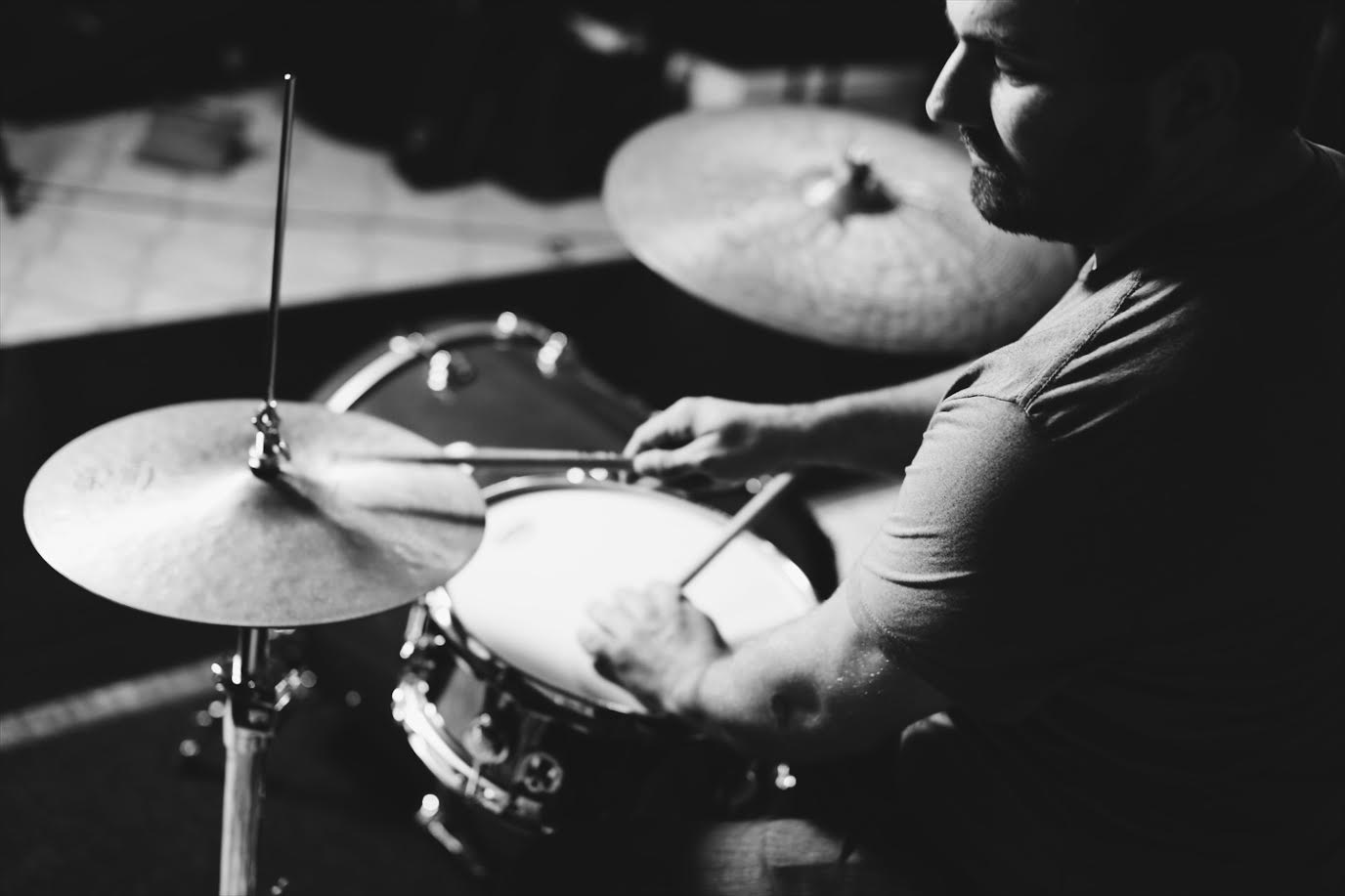
What other products do you have?
All of them…. haha. I use ADL700, ADL600, Studio One, RML32, Studio One remote, Central Station Plus, Temblor 10, Eris 5, Eris 8, Sceptre 8, FaderPort, Air 12.
Why did you choose Notion as your favorite?
As an educator, Notion is the easiest and most fun product to teach others. You can do so much with it and it helps your workflow—more on that later. I like sharing that with others.
Tell us about a successful event you worked.
I attend education conferences year-round and work one-on-one with teachers to find the best solution for their instructional, rehearsal and performance spaces.
What are you currently working on–What’s next for you?
In the summer, music educators and students are involved in many music camps, marching band activities, and Drum & Bugle Corps tours. PreSonus provides the on-the-field reinforcement for The Blue Devils, The Phantom Regiment, Spirit of Atlanta, and many other successful competitive programs. Marching groups these days have significantly more audio technology requirements, whether it be scenes, routing, or remote control. I’m working with them to ensure groups have an easy-to-use, powerful, and flexible solution that fits their needs.
Got some tips?
The power of Notion is in the simplicity of the workflow and the flexibility to use it across multiple devices. The graphic display appears very sleek, but it’s a very powerful notation program, with some surprisingly quick engraving tools. My first tip is to learn the keyboard shortcuts on a computer, which are super intuitive (q=quarter note, d=dot, <=crescendo, #=sharp). On a computer/laptop or iPad, I suggest the handwriting feature, which enables you to write directly on the score with a mouse, finger, stylus or the Apple Pencil.
Anything else you want to share?
Notion is tightly integrated with Studio One. Sometimes, the classical musician in me wants to compose in Notion, then send the score to Studio One (I simply click “Send to Studio One”), where I can then use Studio One to produce tracks around my score. Other times, I’d prefer to write a song on guitar and vocals, and then “Send to Notion” so I can write scoring around my song.
Notion is available at a discounted price for Studio One owners: $49 for Studio One Professional users and $99 for Studio One Artist users.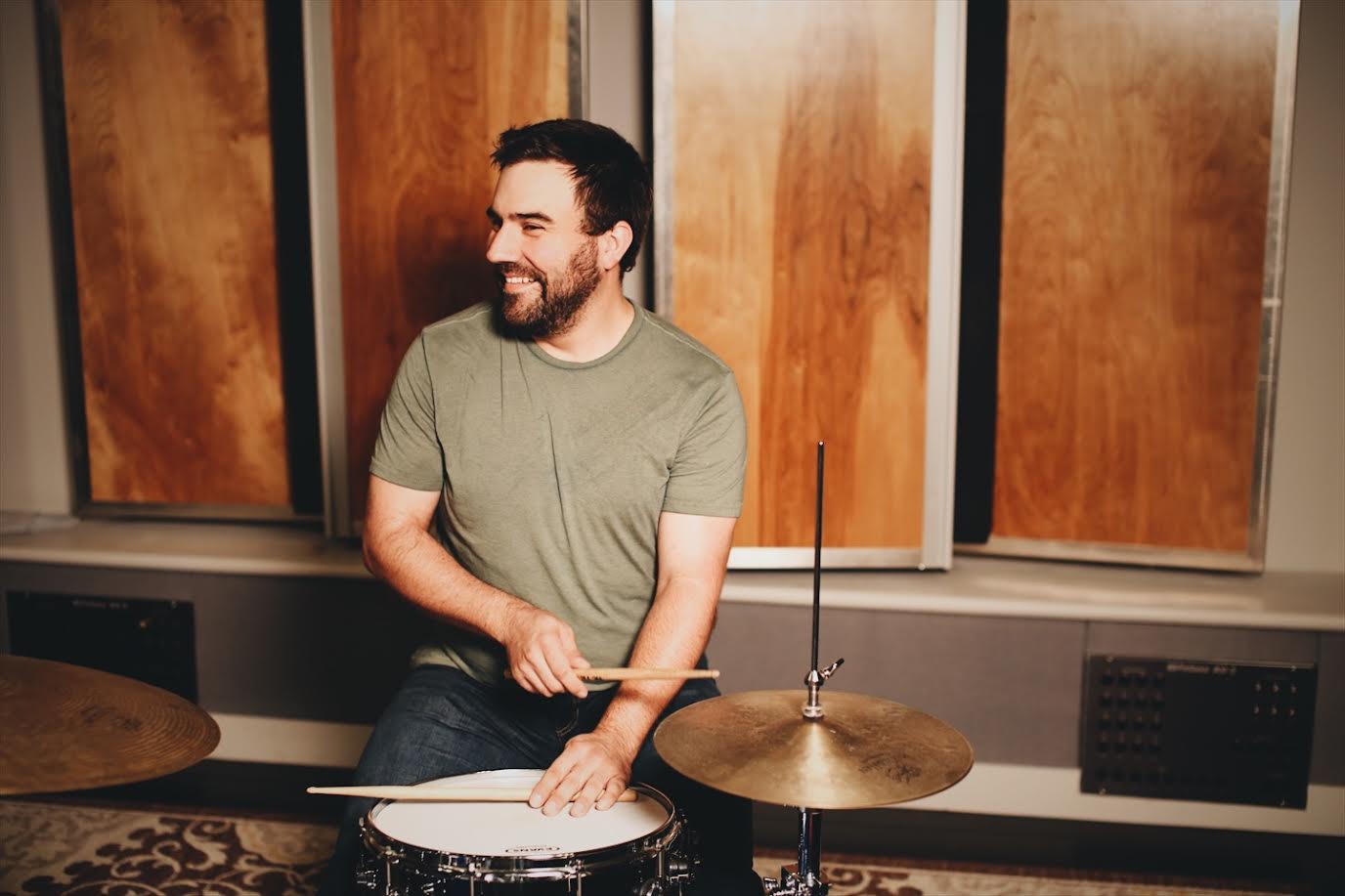
Click here for more info and to purchase Notion!
Nikola Jeremic on Composing for Starpoint Gemini Warlords in Studio One
[Nikola Jeremic is a longtime PreSonus user, fan, and all-around good friend to the company. He’s written outstanding blog pieces for us in the past, and this is no exception! Today he sheds some light on the oft-misunderstood process of music and audio for computer games, in particular, the just-released science fiction epic “Starpoint Gemini Warlords.”]
How is doing music for games different than doing music for film or TV? What features in Studio One make it particularly well-suited for this application? 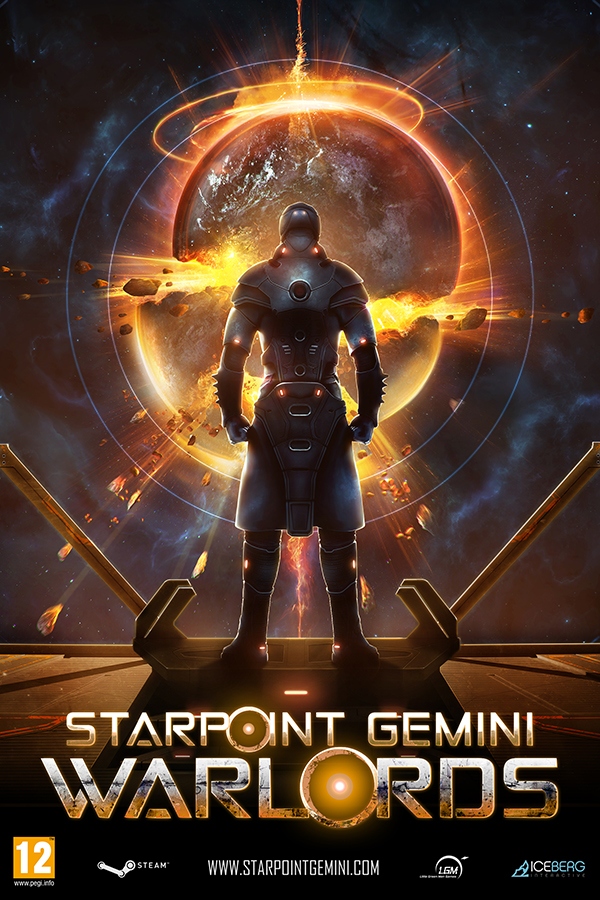
Doing music for games is technically a completely different process than composing for film or TV, because the music in video games is non-linear and interactive, unlike on films and TV. When you compose a cue for film or TV series, you are limited to the timeline of that particular scene, and you have to sync everything to fit in that particular timeline. In the game, the music needs to follow the decisions of the player and fit itself to the various situations the players will get into. That is why I compose a cue for a game in segments. In other words, I create a piece of music that can be divided into looped 8-16 bars parts that can be interchanged inside the audio middleware and each cue has a short ending stinger that can be triggered at any point to end the music cue. This idea is best applied to big action sequences and boss fights. When it comes to ambient atmospheric music, it’s fairly similar, but sometimes it’s not needed to be looped, and you can just transition from one ambient track to another, because I usually compose them in the same key, or I at least make them start and end on the same note for easier transition. That’s the approach I used for Starpoint Gemini Warlords for example.
You’ve been using Studio One for a long time. What are some of the more recent features that you found yourself using during the scoring of Starpoint Gemini Warlords?
Scratch Pads are hands down THE BEST idea ever! I love having the option of being free to experiment and change the arrangement of a cue in a single project that’s opened. It is very useful when I want to create different versions of one track to test how it sounds in different variations. I also love the fact that no matter how many scratch pads you have opened, everything is mixed in the same mix window, so I can bounce different versions very easily and quickly send them off to the developer for listening. I have to say that Studio One Mixer is absolutely the finest and probably the most respected mixing engine out there today. I have a lot of DAWs that I use for composing when collaborating with other people on projects, but I ALWAYS mix my tracks in Studio One. Project page is also awesome, especially when I need to deliver a big amount of mastered tracks to a client and I need to make sure they all sound the same and have the same levels. It’s just amazing, and the fact that I can quickly take care of meta-tags and add album art cover is really cool. The official soundtrack for Starpoint Gemini Warlords is being prepared in Project page, and it makes my life a whole lot easier. I also love the fact that it has all the needed metering in a single window, so I don’t have to load other plugins and use up my CPU. Bouncing in place and converting tracks in project pool is also a feature I use a lot. Creating FX chains with various plugins has made my mixing and sound designing process lightspeed faster, because I can always recall a preset I have created and use it over and over again no matter what plugins I have in the chain. Mojito is still my favorite go-to synth for bass lines. I generally love the sleek and clean look of Studio One interface and its plugins, because it makes my job a lost faster and easier to do without the need to think about “ooh what does this button do?” or spend a lot of time in sub-menus to find the option I need.
Do you use the Notion integration?
Yes I do. Not always, but I most of the time when I am working on piano and orchestral pieces, I always check my score sheet with Notion. What I’d love to see in the future is having Notion editor as an actual part of Studio One Pro. For example, when you open up a midi editor, you can also switch to Notion editor in the same window and tweak the notes on the staff.
Does your score consist of recordings of live instruments or are you using virtual instruments exclusively? If so, which ones?
The score for Starpoint Gemini Warlords consists of both virtual and live instruments. All of the guitar and bass parts are recorded via my FireStudio Project interface, and I also recorded my external hardware synths through FireStudio. This is mostly synth-oriented soundtrack that pays the homage to some of our favorite games and sci-fi franchises. My main synths here were my hardware synths Yamaha DX7 and KORG Volca Bass and Volca Keys, and all of them were processed through my guitar pedals, but regarding the software synths, I used Arturia V collection (mostly MiniMoog V, CS-80 V, ARP 2600 V, and Modular V) and U-He Zebra 2. I also used Mojito for basses and Mai Tai for some pad and drone sounds that were later processed via different FX plugins.
As Starpoint Gemini Warlords is clearly a Space Opera of sorts, do you take any inspiration from John Williams’ use of leitmotif in Star Wars? Any other musical influences you’d care to talk about?
What I love about Little Green Men studio (the developers of the game) is that it’s a group of fanboys and fangirls and it was a lot of fun at brainstorming meetings regarding the soundtrack for the game. Everybody was into sci-fi music and everyone has their own favorite franchises, so I had to do a lot of research and take a listen of various sci-fi game and film soundtracks. There were no traditional leitmotifs for characters, instead we decided to represent each sector in the game with a different melodic theme based on what usually goes down there, so for example more friendly sectors have some light evocative music, alien sectors are more mysterious and feature elven type of vocals and exotic woodwind instruments, while pirate and outlaw sectors are very dark and aggressive in sounds. The biggest inspiration came from video game soundtracks such as Homeworld, EvE Online (I’d love to score that one in the future), Mass Effect, Deus Ex The Human Revolution, and Battlestar Galactica TV series.
Any advice to share for musicians and producers who want to get into game audio or music but don’t know where to start? 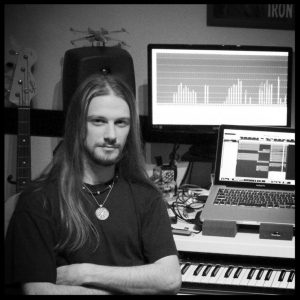
First thing I suggest you do is to join audio societies such as AES (Audio Engineering Society), G.A.N.G. (Game Audio Network Guild), and visit conferences such as GDC (Game Developers Conference) and GamesoundCon. You will meet a lot of people from the industry, and they will all be more than happy to share knowledge and forward you to other people as well. Read books on game audio from publishers like Focal Press for example, I know that helped me a lot. You can always look for some smaller mobile gaming developers out there in your local communities and get in touch with them as well. And the most important thing of all is to learn your craft and learn it good. Don’t get overwhelmed by this or that plugin that’s newest on the market or whatever. Get a set of tools that you like and learn them well inside and out. You will be amazed by how easily you can get great results with bundled plugins that come with your DAW. I still use my Studio One Pro EQ and Compressor most of the time for sampled stuff. Create your own sounds from the stuff that you have. A developer will always learn to appreciate more the fact that you took your sweet time to create something original that’s only for them, than sending them something created with commercial instruments libraries that everyone uses.
Links:
Studio One 3.5 – What’s New and Release Notes
Studio One 3.5 is here! This is a free update for owners of Studio One 3.x. Click “Check for updates” in Studio One’s start page to get it!
Full release notes follow. For a less-technical overview, check out the video below or visit our What’s New page here.
IMPORTANT: This version introduces an updated file format for Songs and Projects for faster
Save / Auto-Save. Files created in 3.5 will no longer open in previous versions of Studio One.
Make sure to work from copies of your existing songs created in Studio One 3.3.4 or older if
you like to continue working with a previous version as well.
______________________________
New features and improvements:
Audio Engine and Performance
Flexible Dropout Protection
• Native Low Latency Monitoring
• Low-latency virtual instrument monitoring
• Multi-processing enhancements for improved CPU balancing
Arrangement and Automation
New shortcut to “Select all Muted Events”
• Copy/Paste Events also copies Layer data
• Import tempo map, time signatures and markers when dragging MIDI file to
Arrangement [Cmd+Alt]
• Maximum Track Delay increased to 1,000ms
• New Track command: “Apply Track Names to Channels”
• “Cursor follows Edit Position” now limited to manually selected events or
ranges
• Batch renaming events always adds leading zero
• Event Inspector: Multi-editing for Event Start and End
• Arranger Track: Move Arranger Section only [Cmd+Alt]
• “Bounce to new Track” now preserves output routing
• Complete Show/Hide for Automation
• Automation Lanes on Instrument Track
• Improved time-stretching accuracy. “Audio Bend” mode now obsolete.
Mixer (Console)
• Mixer Undo
• Remote control of StudioLive Series III Fat Channel and mic pre-amps
• New command: “Remove Track Automation” removes all automation data
• Visual plug-in bypass state in console
Instruments and Plug-ins
Fat Channel XT
• Adjustable level range for Spectrum Meter (all modes)
• Updated micro-views for Spectrum Meter
• 12th octave mode in Spectrum Meter (incl. keyboard scale)
• Loudness Meter now EBU R-128 compliant
• [macOS] MIDI input for AU plug-ins
• Event FX window follows Event selection
• [macOS] Preset list support for AU instruments/plug-ins
• FX Routing: Splitter can now be moved freely
Music Editor
Unlimited number of controller lanes
• Option to “Resize adjacent Events” (multiple overlapping) [Alt]
Score Editing with Notion
• Send audio or note data to existing song
• Tempo map import (drag & drop)
• Other improvements within Notion (ReWire handling, Studio One application
launcher, and more)
Project Page
• Independent Track Markers
• Flexible Loudness Detection options
• New Loudness Meter
• New Spectrum Meter
• DDP import
• Improved meta-data editing
• Pool in Project Page
• New Bounce Track option
• Dynamic search for Songs in Project (improved compatibility)
• Faster rendering (if a Song is used multiple times)
• New command “Bounce Track” (includes Track inserts, not Master FX)
• Extended “Add to Project” menu
• Improved ID-tag export (adding Composer and ISRC)
• User interface improvements
• New “Split Track” and “Split at Cursor” commands + shortcuts
Browser
• New “Construction Kits” node in Loop Browser
• Search fields in Browser and Mixer reset on close
Hardware and Multitouch
• Dual-screen support (Raven MTi)
• Higher MIDI update rate for control surfaces
General
• Delete unsaved files and folders when closing new song w/o saving
• Warnings shown when errors occur while exporting mix in real-time
• Updated FLAC codec (better performance)
• Improved save and auto-save performance for Songs and Projects
• [macOS] Independent recording and playback devices
• Extended Bounce and Export options
• Support for 176.4 kHz sample rate in audio export
• [Developers] Gain Reduction API for VST2
—————————————————————————–
—————————————————————————–
The following issues have been fixed:
• “Invert Selection” didn’t restrict range when Scratch Pads exist
• Arranger Track section copy doesn’t work backwards on timeline
• Pre-recorded notes overlapping loop start are doubled after loop recording
• Fade handles are hard to reach when event volume is not at max.
• Overlapping audio events with fade-in are out of sync
• Crash when recording MIDI in loop
• Play Start Marker affects bounce between markers
• No “Paste” in context menu for Tempo Track
• [ARA] Events show wrong content when split after analysis with Melodyne 4.1
• Crash with NI Komplete Audio 6 when changing sample rate
• Audio time-stretch with bend markers is not exact
• Chorder: Crash when transposing out of range with automation
• Install from “Cloud” inside Studio One 3.3 hangs
• Plug-in menu search box loses focus
• Command for “Show in Finder/Explorer” not working for Macros
• Can’t drag more than one Instrument from Browser
• [macOS] Newly created folders not visible in Browser
• “Copy external files” not working for multiple opened songs
• [macOS] Studio One language changes after re-install
• Crash while closing all songs
• Musicloop exports without audio when routed to outputs other than Main
• Wrong-placed note events in loop recording
• Sustain pedal with latency writes wrong data
• Global plug-in bypass not functional if any plug-in in Chain is disabled
• Spectrum Meter curve has offset depending on FFT size
• Channel buttons missing on Multi-Instrument channels
• [macOS] AU Instruments saved in OFF status load back empty
• [macOS] Kontakt AU not showing all available outputs
• Global deactivate FX not working with disabled tracks
• Inconsistent behavior when chasing long notes
• [Impact] Wrong channel order when moving sub outs in mixer
• Wrong channel order after transform to audio and back
• Wrong channel order between folders and busses
• Wrong channel order when dragging instrument to track
• Studio One will not export note data to Notion if the file has an apostrophe in the name
• [macOS] Crash on start with OSX 10.11 El Capitan
• [macOS] AU presets always marked as edited
• |macOS] Invisible scroll bars in help window
• Offset when dragging audio file with bend-markers to Instrument Track
• Notes are transposed one octave when dragging to new Instrument Track via
Melodyne
Five New Sample Packs from Sample Tekk Now Available for Studio One
Click here to browse and shop!
We’ve got five new amazing sample sets from Sample Tekk that we’ve just added to shop.presonus.com. These packs are compatible with Studio One Prime, Artist, and Professional (version 3.3.4 and higher).
The White Grand
Sample Tekk recorded The White Grand with the finest equipment available, using a specially-designed digital recording technique to give you unequaled performance and sound. Prepare to explore a tactile and expressive feast, not heard in many sampled pianos today.
INIL Choir
Get the crazy ethereal choir sounds of “I’m Not In Love” by 10CC with INIL Choir! These choirs are unique—the combination of voices and the way they were produced have given them a sound that’s truly one of a kind. Now, SampleTekk, in cooperation with Eric Stewart of 10CC are very proud to release of The INIL Choir, thus taking one of the most famous analog samples into the digital era.
Tubed Keys
Great-sounding Rhodes for Studio One, recorded through a Fender Twin as the Rhodes was intended to be heard. Sample Tekk didn’t go for 80s sheen and gloss with lots of tines and overtones. The Tubed Rhodes is more representative the 70’s: a gritty, hard-core rythm’n’blues kind of sound.
The Rain Piano
Somber sounds of a piano that has been left out in the rain and elements. Musical, but with extra overtones and character. The Rain Piano has become a kind of a synonym for character pianos. It has been used and is still used on countless productions where you want something that adds a different flavor rather than using a normal piano.
Singularis
Old School piano recorded with vintage mics, tape, and preamps. In glorious MONO!
Click here to browse and shop!
A Cubase User, a Logic User, and a Digital Performer user Find Common Ground in Studio One
[We recently came across a great story—three different producers, all of whom use different DAWs, needed to collaborate on a single project. They decided that Studio One offered them the best of all three worlds, and chose it for their collaborative effort. Details below courtesy of Roger Hooper, Robert Holmes, and George Napier.]

George Napier’s Studio
George Napier kicks things off by describing the task at hand, as well as the backgrounds of the collaborators.
“Robert, Roger, and I took a group of 11 executives from a 75-person tech startup into Studio A of Omega Studios for two days of team building. We needed to prepare backing tracks and beds for them to play against. Roger is a film composer, former Logic guy and current Mac-based Cubase user. Robert is a musician and games music composer and a 20 year die hard Digital Performer user who switched to Windows on DP and was not liking the experience,” says George. “I’m a composer/sound designer and a bit of a serial monogamist when it comes to DAWs. I’ve used Studio One since version 1, left it for Logic/Cubase at 2.6, and came back to try it out with the release of 3 (all on Mac). FYI: We all work together on projects for each other’s companies. This particular project was done under Robert’s company ResonantClarity.
Roger Hooper is a longtime Cubase and Logic user who was new to Studio One for this collaboration. His impressions and description of the collaborative workflow follow.
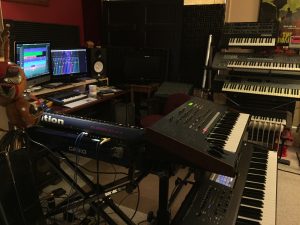
Roger Hooper’s Studio
Robert Holmes is a long-time Digital Performer user who made the switch to Studio One after a 20-year commitment to DP. He’s a self-proclaimed “old pop/rock studio guy from LA who ended up doing game scores in the golden age of adventure games.”

Robert Holmes’ Studio
“I had one interesting experience where I was mixing, and I was getting lots of crosstalk,” recalls Holmes. “And it was actually very cool from a sonic point of view, but it was making mixing a challenge. That’s when I discovered the Console Shaper had accidentally been activated on the master track somehow and was in Crosstalk mode. So YES, the crosstalk really works if you want that Gold Star Studio Wall of Sound.”Despite a lengthy relationship with Digital Performer, Holmes has taken the plunge and made the switch to Studio One as a result of his experiences in this project.
“I never looked back.”
James F. Reynolds on Studio One
[This just in from James F. Reynolds, pop and dance music’s “secret weapon.” He has mixed and produced a wide range of acts including Ellie Goulding, Emeli Sande, Years and Years, Tinie Tempah, and The Saturdays. Last year he made the switch to Studio One and was kind enough to share his insights with us.]
• For what applications are you using Studio One Pro? (Example: for recording, composing, sound design, and so on; in a commercial studio, project studio, for live recording, etc.)
I use Studio One 3 Professional for mixing, production, and recording.
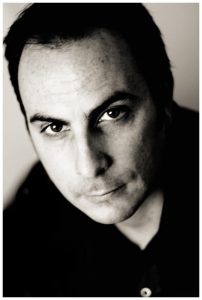
James F. Reynolds
• What led you to choose Studio One? Was it the company’s reputation, audio quality, ease of use, specific features, price, other factors?
I spent many years using a combination of Logic, Pro Tools, and Ableton Live, as they all have strengths in different areas. I had been searching for a while for a DAW that has the best of all these platforms, for example:
- The creative speed of Ableton
- The accuracy and mixing ability of Pro Tools
- The lay out and ease of use of Logic.
Last year I had quite a few producers in my studio talking about Studio One and decided to investigate further. After taking some time to get to know the program, it became apparent that this was a program that has been thought out really well and ticks the box of being a one stop shop for mixing/production and writing.
• Having used Studio One, what do you like most about it?
I have used it consistently for 5 months now and it has sped up my mixing and overall workflow. One of the best features is being able to set up a series of commands using Macros. It’s also very stable.
• What Studio One features have proven particularly useful and why?
The arranger track is very handy, as often when I am mixing a song, the label wants extended versions. The Arranger and also to try out different structures within the arrangement. This is very easy to do using the arranger as it can copy any section with all the automation related to it.
• Any user tips or tricks or interesting stories based on your experience with Studio One?
My tip is this: if you are trying Studio One out, stick with it. It’s always very difficult switching from a platform that you use day in day out for many years as everything is second nature. It takes a while to get back to this speed on a new platform but if you persevere it pays off !
• Please give me some basic background info on your career and current projects, credits, and so on.
I am mainly known as a mixer. I am currently mixing Emeli Sande and before that was mixing Ellie Goulding “Still falling for you” (U.S.A radio mix) and Kelly Clarkson. I also mix for a K Pop band called B.T.S who’s album last year broke records. I co wrote “Drinking from the bottle” with Mark Knight and Calvin Harris and Tinie Tempah. For more info, check out www.jamesfreynoldsmixing.com
• Any final comments about PreSonus and Studio One?
I am really excited about the future of Studio One and have been really encouraged by a development team that actually take on board feedback from mixers and producers and often implement ideas if they are good. This was a big frustration with other DAWs, as feedback was not listened to or acted on.
The Studio 192, Eris E44 MTM monitors, Studio One and Thou
Baton Rouge-based Thou—winners of Pitchfork’s Metal Record of the Year in 2014—recently took a Studio 192 on the road to record rehearsal sessions and demos for a forthcoming full-length.
Opportunities for collaborative songwriting had become more difficult for the band, as their members have scattered across the country. They typically only get together for tours and shows, making songwriting and recording opportunities somewhat scarce.
Not anymore. Recording straight into Studio One via the Studio 192 allowed the band to write and record in whatever impromptu spaces their tour found them in. Josh Nee (Drums) took recordings home to edit and mix demos for the record after returning from their most recent tour. The full-length, Magus, is on its way.
Learn more:
Chocolate Audio Pianos for Studio One
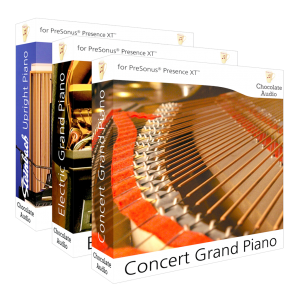
Looking for some of the best-sounding pianos you can get for Studio One? Look no further than this Piano Collection from Chocolate Audio. Three different pianos are available, each recorded with high-quality mics and expensive preamps. They also take advantage of Presence XT’s advanced scripting functionality to simulate the behavior of these beloved instruments as accurately as digitally possible.
If you’re not sure which piano is right for you and your music, check out the descriptions below. And if you’re still not sure after reading, get the combo pack of all three. The Chocolate Audio Piano Collection for Studio One is available only at shop.presonus.com.
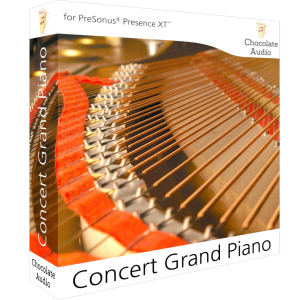 The Concert Grand:
The Concert Grand:
A recreation of a world-class concert grand piano sound as found in a Steinway D274 grand coda. This piano is gorgeous and rich in sound with a very well-balanced tone, very well fit for classical but equally at home with jazz and any scenario where a full piano sound is called for.
Great attention was paid to recreate this huge concert’s signature full and balanced sound through sampling. The sample set features 11 dynamic layers and a sustain pedal resonances layer, 12 release sample layers and pedal and key release noise effects tuned to perfection using Presence custom scripting. Studio One Professional users can load the multi-instrument preset which combines the two microphone sets for an even fuller control on its sound.
The Concert Grand offers two different phase-coherent recording setups: a player’s perspective recorded with Schoeps CMC6 microphones and a listener’s perspective recorded right at the edge of the lid with Neumann KM microphones, all matched-pairs going through Millennia preamps.
Electric Grand: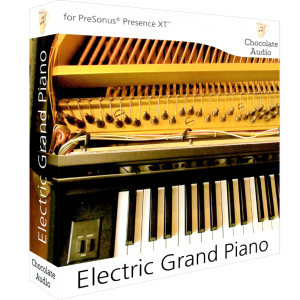
A top-notch rendition of a famous Japanese electric grand piano. At that time it was dubbed as “compact,” which it actually was when compared to the weight and size of an acoustic piano. Its mid-rangey character is due to the presence of a piezo pickup under the saddle of each string. Full restoration was carried out and proper tuning applied on the piano before sampling. A classic sound heard on countless hit records in the 70s-80s is now reborn inside Studio One.
Achieving a quality level on par with our goals from this piano was tough. The onboard electronics are noisy and the piano picks up a lot of ambient noise even if it’s electric (imagine a guitar with 88 strings!). Through attention and care, we managed to capture what we believe is the best rendition of this classic electric grand piano. The sample set features 12 dynamic layers, a sustain pedal resonance layer, nine release sample layers, and pedal and key release noise effects tuned to perfection using Presence custom scripting.
The Electric Grand was sampled direct from the output to the preamp and converter. All of the behavioral details of the piano have been re-created through the use of Presence XT’s custom advanced scripting.
Steinbach Upright: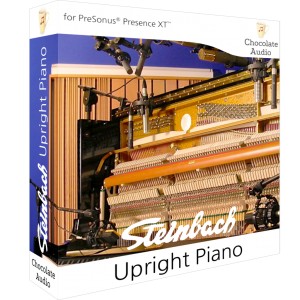
A high quality Italian-made upright piano sampled in full detail. The recording techniques used make this piano fit for many different uses, from classical to pop, country, rock and beyond.
This is a world-class piano recorded in a state-of-the-art studio with choice microphones and audiophile preamps and converters. Great attention was paid to recreate Steinbach’s signature full, organic, sound through sampling. The sample set features eight dynamic layers and a sustain pedal resonances layer, four release sample layers and pedal and key release noise effects, tuned to perfection using Presence custom scripting.
The Steinback Upright was recorded with two different phase-coherent setups: Blumlein stereo and Spaced stereo, recorded with Royer R121 matched-pair ribbon mics through Millennia preamps. Studio One Professional users can load the multi-instrument preset which combines the two microphone-sets for an even fuller control on its sound.
Last but not least:
The Chocolate Audio Pianos are compatible with Studio One 3.2 or later: Prime, Artist, and Professional editions.
All of the pianos in this family have the following onboard script controls:
- Tuning: 440/442 Hz
- Level control for Sustain Resonances, Pedal Noise and Release samples
- Velocity Curve control
- Hold, Decay, Release envelope controls
- Touch Response* control: sets the amount of pre-attack key noise heard, sets the attack time at higher settings.
